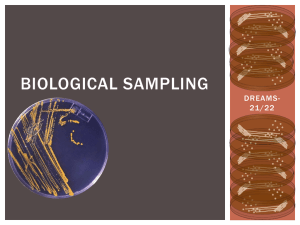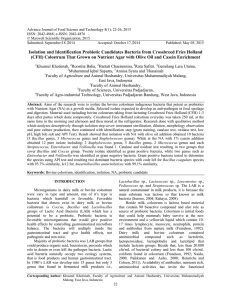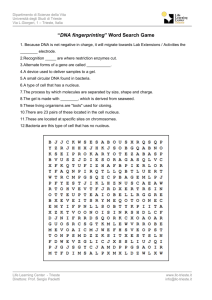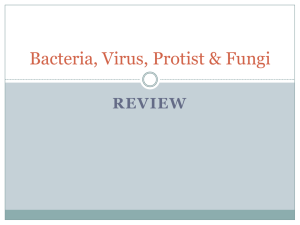Advance Journal of Food Science and Technology 8(1): 22-26, 2015
advertisement
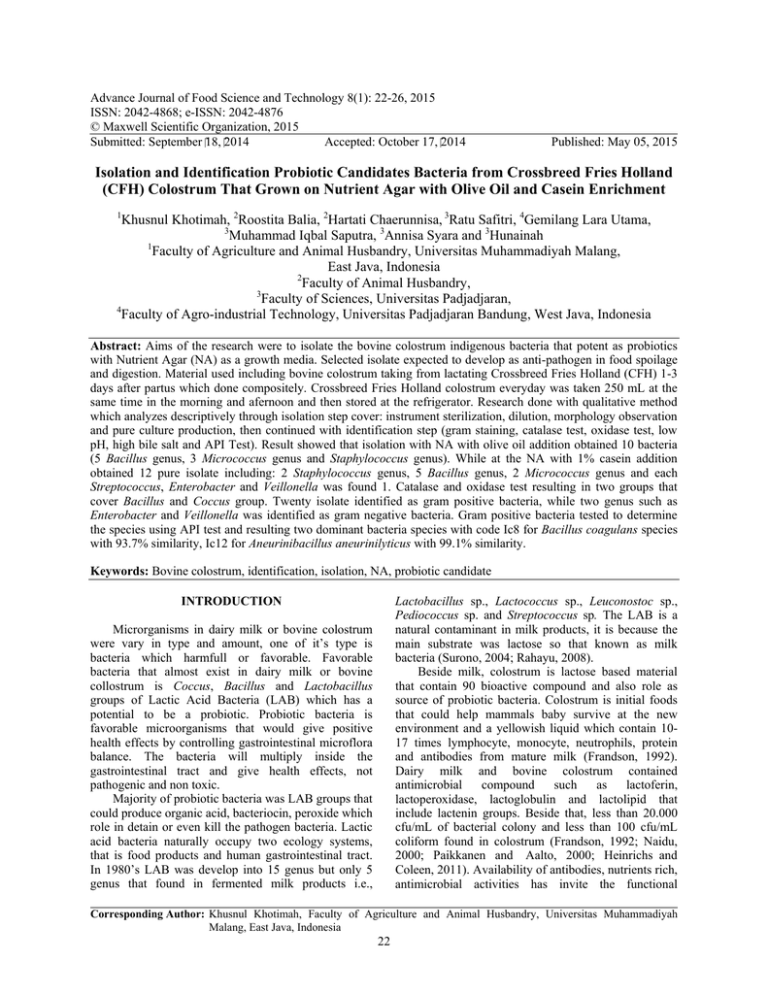
Advance Journal of Food Science and Technology 8(1): 22-26, 2015 ISSN: 2042-4868; e-ISSN: 2042-4876 © Maxwell Scientific Organization, 2015 Submitted: September 18, 2014 Accepted: October 17, 2014 Published: May 05, 2015 Isolation and Identification Probiotic Candidates Bacteria from Crossbreed Fries Holland (CFH) Colostrum That Grown on Nutrient Agar with Olive Oil and Casein Enrichment 1 Khusnul Khotimah, 2Roostita Balia, 2Hartati Chaerunnisa, 3Ratu Safitri, 4Gemilang Lara Utama, 3 Muhammad Iqbal Saputra, 3Annisa Syara and 3Hunainah 1 Faculty of Agriculture and Animal Husbandry, Universitas Muhammadiyah Malang, East Java, Indonesia 2 Faculty of Animal Husbandry, 3 Faculty of Sciences, Universitas Padjadjaran, 4 Faculty of Agro-industrial Technology, Universitas Padjadjaran Bandung, West Java, Indonesia Abstract: Aims of the research were to isolate the bovine colostrum indigenous bacteria that potent as probiotics with Nutrient Agar (NA) as a growth media. Selected isolate expected to develop as anti-pathogen in food spoilage and digestion. Material used including bovine colostrum taking from lactating Crossbreed Fries Holland (CFH) 1-3 days after partus which done compositely. Crossbreed Fries Holland colostrum everyday was taken 250 mL at the same time in the morning and afernoon and then stored at the refrigerator. Research done with qualitative method which analyzes descriptively through isolation step cover: instrument sterilization, dilution, morphology observation and pure culture production, then continued with identification step (gram staining, catalase test, oxidase test, low pH, high bile salt and API Test). Result showed that isolation with NA with olive oil addition obtained 10 bacteria (5 Bacillus genus, 3 Micrococcus genus and Staphylococcus genus). While at the NA with 1% casein addition obtained 12 pure isolate including: 2 Staphylococcus genus, 5 Bacillus genus, 2 Micrococcus genus and each Streptococcus, Enterobacter and Veillonella was found 1. Catalase and oxidase test resulting in two groups that cover Bacillus and Coccus group. Twenty isolate identified as gram positive bacteria, while two genus such as Enterobacter and Veillonella was identified as gram negative bacteria. Gram positive bacteria tested to determine the species using API test and resulting two dominant bacteria species with code Ic8 for Bacillus coagulans species with 93.7% similarity, Ic12 for Aneurinibacillus aneurinilyticus with 99.1% similarity. Keywords: Bovine colostrum, identification, isolation, NA, probiotic candidate Lactobacillus sp., Lactococcus sp., Leuconostoc sp., Pediococcus sp. and Streptococcus sp. The LAB is a natural contaminant in milk products, it is because the main substrate was lactose so that known as milk bacteria (Surono, 2004; Rahayu, 2008). Beside milk, colostrum is lactose based material that contain 90 bioactive compound and also role as source of probiotic bacteria. Colostrum is initial foods that could help mammals baby survive at the new environment and a yellowish liquid which contain 1017 times lymphocyte, monocyte, neutrophils, protein and antibodies from mature milk (Frandson, 1992). Dairy milk and bovine colostrum contained antimicrobial compound such as lactoferin, lactoperoxidase, lactoglobulin and lactolipid that include lactenin groups. Beside that, less than 20.000 cfu/mL of bacterial colony and less than 100 cfu/mL coliform found in colostrum (Frandson, 1992; Naidu, 2000; Paikkanen and Aalto, 2000; Heinrichs and Coleen, 2011). Availability of antibodies, nutrients rich, antimicrobial activities has invite the functional INTRODUCTION Microrganisms in dairy milk or bovine colostrum were vary in type and amount, one of it’s type is bacteria which harmfull or favorable. Favorable bacteria that almost exist in dairy milk or bovine collostrum is Coccus, Bacillus and Lactobacillus groups of Lactic Acid Bacteria (LAB) which has a potential to be a probiotic. Probiotic bacteria is favorable microorganisms that would give positive health effects by controlling gastrointestinal microflora balance. The bacteria will multiply inside the gastrointestinal tract and give health effects, not pathogenic and non toxic. Majority of probiotic bacteria was LAB groups that could produce organic acid, bacteriocin, peroxide which role in detain or even kill the pathogen bacteria. Lactic acid bacteria naturally occupy two ecology systems, that is food products and human gastrointestinal tract. In 1980’s LAB was develop into 15 genus but only 5 genus that found in fermented milk products i.e., Corresponding Author: Khusnul Khotimah, Faculty of Agriculture and Animal Husbandry, Universitas Muhammadiyah Malang, East Java, Indonesia 22 Adv. J. Food Sci. Technol., 8(1): 22-26, 2015 microorganisms such as Lactobacillus and Bifidobacterium genus which used widely as probiotics LAB. Lactic acid bacteria isolated from colostrum was 55.3% Lactobacillus genus which consist of 64% L. plantarum, 16% L. fermentum and 9% L. pentosus. Twenty eight percent of strain isolated from human colostrum shown resistance to pH of gastrointestinal tract and high bile salt concentration. While the LAB that isolated from bovine colostrum could produce hydrogen peroxide, diacetyl, aldehyde and bacteriocin which is bactericidal towards gram positive and negative bacteria, so that used as probiotics (Collado et al., 2009; Dubos et al., 2011). Specific media will needed to make grow selected probiotic LAB strain, especially isolated from bovine colostrum. Nutrient Agar used as general media with addition of olive oil and casein as enrichment, which role as fat and protein sources and also gave high nutrient characteristics as same as bovine colostrum. The research objective was to isolate bovine colostrum bacteria that potential as probiotics which grown at enriched NA, therefore could be used as anti-pathogen agent in food spoilage and gastrointestinal tract. Colostrum antimicrobial compound such as lactoferin was high at 24 h after partus and then decrease in line with the increase of milking days (Rahman, 2010; Khotimah and Pujo, 2013). The antimicrobial activity inside the colostrum getting lower so that the total bacteria colony increased. Meanwhile, higher total bacteria colony in mix samples resulted by storage time and temperature. Six days storage in refrigerator temperature gave chance for microorganisms to grow. Isolation CFH colostrum bacteria on enriched NA: Thirteen bacteria isolate grown at NA media with olive oil enrichment was isolated from CFH colostrum. Identification of isolated bacteria resulting in 5 bacteria isolate of Bacillus sp., 3 bacteria isolate of Micrococcus and 2 genus. Olive oil addition function as fat source on NA media, meanwhile it can prevent carbohydrate fermentation that happen which could detain proteolytic bacteria growth (Pelczar, 2005; Ray, 2001). Bacteria that grow majority derived from mixture (composite) CFH colostrum samples and isolated 10 purified bacteria on slope agar then identified biochemically (Table 2). Staining gram showed that 10 bacteria isolate was gram positive bacteria which could maintain dark purple of metal color after it wash with alcohol (Feliatra et al., 2004). Catalase test was done to determine aerob, anaerob or facultative anaerob bacteria, with all the bacteria was positives. Oxidase test determine enteric bacteria which resulting 7 non enteric and 3 enteric bacteria. Bacteria colony isolated on NA media with 1% casein enrichment was 12 bacteria isolate then identified by morphology identification, gram staining, catalase and oxidase test. The result shown six genus found. i.e., Bacillus, Micrococcus, Streptococcus, Staphylococcus, Enterobacter and Veillonela. As gram positives bacteria 5 Bacillus, 2 Micrococcus, 1 Streptococcus, 2 Staphylococcus was found with Enterobacter and Veillonela also identified as gram negatives bacteria. Bacillus identified as bacil form bacteria with 0.3-2.2×1.27-7.0 µm length, gram positives, catalase positives, oxidase negatives and morphology type of white or yellowish color, flat or irregular fringe with convex surface (Pelczar, 2005). Others gram positives bacteria isolated was Micrococcus which have circular form, 0.5-3.5 µm diameter, catalase positives with morphology type of MATERIALS AND METHODS Colostrum taken compositely morning and afternoon from lactating CFH at 1-3 days after partus at farmer group KUBE PSP Maju Mapan, then stored at the refrigerator. Isolation of bacteria was done using enriched NA with composition 28 g NA in 1 L aquadest and two different enrichment i.e., 1% casein and olive oil. Bacterial colony appears purified and identified with gram staining, catalase test, oxidase test, low pH test, high bile salt test (2%) and API test (Fardiaz, 1993; Ruzanna, 2011; Safitri, 2011). RESULTS AND DISCUSSION Total bacteria colony of CFH colostrum: Result (Table 1) showed that average total bacteria colony of CFH colostrum was 21.3×108±5.72×108 cfu/mL and it’s increase in line with milking days, while higher total bacteria colony shown by composite samples. The increase of total bacteria colony happen at different milking days because the decrease of antimicrobial compound of CFH colostrum (Khusnul, 2013). Table 1: Total bacteria colony of CFH colostrum Repetition (×108) ---------------------------------------------------------------------1 2 Milking day Day 1 15.30 17.37 Day 2 17.89 21.16 Day 3 22.92 23.52 Mix (composite) 27.72 24.49 Average total bacteria colony 23 Total (cfu/mL) 32.67 39.05 46.44 52.21 Average (cfu/mL) 16.34 19.53 23.22 26.11 21.30×108 Adv. J. Food Sci. Technol., 8(1): 22-26, 2015 Table 2: Characteristic of bacteria isolated from CFH colostrum grown at NA with olive oil enrichment Test ------------------------------Code Isolate character Gram stain Catalase Oxidase Ik1 Yellow egg flat fringe convex surface Small, bacil, spores gram + + Ik2 Yellow egg flat fringe flat surface Coccus, separated gram + + Ik5 Clear white flat fringe flat surface Small, bacil, fat, spores ++ -Ik6 Creamy milky white flat fringe Coccus, separated gram + + + convex surface Ik7 Milky white irregular fringe convex Coccus, separated, clustered gram + + surface Ik8 Yellow egg flat fringe convex surface Tetra coccus gram + + + Ik9 Ik10 Ik12 Ik18 Yellowish white flat fringe convex surface Milky white flat fringe convex surface Dark yellow flat fringe covex surface Clear white irregular fringe flat surface Ic17 Ic20 Ic21 White irregular fringe convex surface Milky white flat fringe convex surface Yellowish white irregular fringe convex surface White flat fringe flat surface White flat fringe flat surface Yellowish white irregular fringe convex surface Staphylococcus sp. Small, bacil, fat, spores gram + + - Micrococcus (tetragenous) Bacillus sp. Small, bacil, short, spores gram + Coccus, separated gram + Bacil, spores gram + + + + + - Bacillus sp. Micrococcus sp. Bacillus sp. Table 3: Characteristic of bacteria isolated from CFH colostrum grown at NA with 1% casein enrichment Test -----------------------------Code Isolate character Gram stain Catalase Oxidase Ic1 White irregular fringe convex surface Bacil, spores gram + + Ic2 White irregular fringe flat surface Coccus, separated gram + + Ic3 White flat fringe flat surface Coccus, chain -+ -Ic5 Milky white irregular fringe flat surface Coccus, separated, concentrated gram + + Ic7 Yellow irregular fringe convex surface Coccus gram + + + Ic8 White irregular fringe convex surface Bacil, spores gram + + Ic11 Ic12 Ic13 Genus prediction Bacillus sp. Micrococcus sp. Bacillus sp. Staphylococcus sp. Bacil, no spores gram Bacil, spores gram + Bacil, spores gram + + + + - Genus prediction Bacillus sp. Staphylococcus sp. Streptococcus sp. Staphylococcus sp. Micrococcus sp. Bacillus sp. Megaterium Enterobacter Bacillus sp. Bacillus sp. Bacil, spores gram + Coccus gram Coccus gram + + + + - Bacillus sp. Veillonella Micrococcus sp. white or yellowish color, irregular fringe and convex surface. Streptococcus and Staphylococcus also have circular form and gram positives, but Staphylococcus was catalase positives, has 0.5-1,5 µm diameter, single or paired, irregular concentrated. While Streptococcus has circular form, less than 2 µm diameter, chained, gram positives, catalase negatives with morphology white color, flat fringe and flat surface (John et al., 1984; Fardiaz, 1993; Ray, 2001; Pelczar, 2005). Enterobacter and Veillonella is gram negatives bacteria, which is harmfull bacteria with circular form, catalase positives, non-motil and no spores. This two bacteria identified as contaminant of CFH colostrum samples, because the bacteria was not came from the CFH colostrum. Generally bovine colostrum contain favorable probiotic bacteria that could give positive health effects (Finamore et al., 2012). Beside both bacteria, Micrococcus also identified as CFH colostrum contaminant and include milk spoilage bacteria that could hydrolyze protein into amino acid and degrade fat with lipase enzyme so that milk goes slimy (Ray, 2001; Vimont et al., 2006). Bacteria isolated from CFH colostrum that grown at enriched NA with olive oil and 1% casein addition (Table 3) dominated by Bacillus sp. genus. Continue with that, API test 50 CHB was done (Fig. 1) and the result gave 2 dominant species with code Ic8 for Bacillus coagulans with 93.7% similarity and Ic12 for Aneurinibacillus aneurinilyticus with 99.1% similarity. Low pH and bile salt test for selected CFH colostrum bacteria isolate: Selected bacteria grown in media that has low pH (pH 4) and high bile salt concentrations (2% bile salt). Low pH and high bile salt screening was done to determine survival ability of selected bacteria at gastrointestinal tract as requirement for probiotic bacteria candidates. Positive result, shown by muddy and deposition form on Nutrient Broth with pH 4 and 2% bile salt concentrations as growth media. The result showed that CFH colostrum were potential as source of LAB probotic candidates that are gram positive bacteria with ability in producing organic acid, bacteriocin, peroxides and antimicrobial compounds. Lactic acid bacteria needs complex nutrients, therefore the habitat should be nutrient rich such as milk, meat, drinks or vegetables. Crossbreed Fries Holland Colostrum is one of rich nutrients liquid, so that a lot of bacteria grow on it especially LAB that 24 Adv. J. Food Sci. Technol., 8(1): 22-26, 2015 GOOD IDENTIFICATION Strip API 50 CHB V4.0 Profile Note Significant text % ID T Test against Bacillus coagulans 99.1 0.48 MAE 9% Next taxon % ID T Test against Bacillus circulans 0.40 0.22 AFB 9% ESC 9% SAL 9% GAL 0% NAG 98% MAL 88% TRE 98% Fig. 1: API test result of selected isolate isolated and selected in this research. Two selected bacteria was potential as probiotic candidate, because the survival ability at low pH and high bile salt concentrations that similar with the gastrointestinal tract. The isolate expected to be through high gastric acidity and excretion of bile salt that could harmfull to the isolate (Salminen et al., 1999; Surono, 2004; Susanti et al., 2007). Dubos, C., N. Vega, C. Carvallo, P. Navarrete, C. Cerda, O. Brunser and M. Gotteland, 2011. Identification of Lactobacillus spp in colostrum from chilean mothers. Arch. Latinoam. Nutr., 61(1): 66-8. Fardiaz, S., 1993. Mikrobiologi Pangan. Gramedia, Jakarta. Feliatra, I. Efendi and D.E. Suryadi, 2004. Isolasi dan identifikasi bakteri probiotik dari ikan kerapu macan (Ephinephelus fuscogatus) dalam upaya efisiensi pakan ikan. J. Natur. Indonesia, 6: 75-80. Finamore, A., M. Roselli, M.S. Britti, N. Merendino and E. Mengheri, 2012. Lactobacillus rhamnosus GG and Bifidobacterium animalis MB5 induce intestinal but not systemic antigen-specific hyporesponsiveness in ovalbumin-immunized rats. J. Nutr., 142: 375-381. Frandson, R.D., 1992. Anatomi dan Fisiologi Ternak. Edisi ke-4, Translated by B. Srigandono and dan K. Praseno. Gadjah Mada University Press. Yogyakarta. Heinrichs, J. and J. Coleen, 2011. Composition and hygiene of colostrum in pennsylvania modern dairy farms review. J. Dairy Sci., John, G.H., R.K. Noel and D.H. Bergey, 1984. Manual of Systematic Bacteriology. 9th Edn., Williams and Wilkins, Baltimore, London. Khotimah, K. and D.D. Pujo, 2013. Deteksi kadar laktoferin pada laktasi dan waktu pemerahan yang berbeda pada sapi perah PFH. Laporan Penelitian. Universitas Muhammadiyah Malang. CONCLUSION Isolation and identification CFH colostrum bacteria that grown in NA enriched by olive oil resulting in 3 genus i.e., Bacillus, Micrococcus and Staphylococcus, meanwhile the isolate grown in NA enriched by 1% casein shown 6 genus i.e., Bacillus, Staphylococcus, Micrococcus and Streptococcus as gram positives strain, also Enterococcus and Veillonella as gram negative strain. Dominant genus that isolated was bacillus, so that two bacteria isolate was taken and identified with API test that resulting 93.7% similarity with Bacillus coagulans for Ic8 and 99.1% similarity with Aneurinibacillus aneurinilyticus for Ic12. Selected bacteria was potential as probiotic candidates because the survival ability at low pH and high bile sat concentrations. REFERENCES Collado, M.C., E. Isolauri, S. Salmien and Y. Sanz, 2009. The impact of probiotic on gut health. Curr. Drug Metab., 10(1): 68-78. 25 Adv. J. Food Sci. Technol., 8(1): 22-26, 2015 Khusnul, K.D.F., 2013. Kualitas mikrobiologi kolostrum sapi Perah FH pada waktu pemerahan yang berbeda di peternakan rakyat. J. Ilmu Ternak., 13(2): 13-17. Naidu, A.S., 2000. Natural Food Antimicrobial System. CRS Press, Washington, D.C. Paikkanen, R. and J. Aalto, 2000. Growth Factors and Antimicrobial Factors of Bovine Colostrum. Turku Technology Centre, Biocity, 20520 Turku, Finland. Retrieved from: http://dx.doi.org/10.1016/S09586946(97)00022-8. Pelczar, D.C., 2005. Dasar-Dasar Mikrobiologi. Jilid I. Penerbit Universitas Indonesia, Jakarta. Rahayu, E.S., 2008. Probiotic for Digestive Health. Food Review-Referensi Industri dan Teknologi Pangan Indonesia. Retrieved from: http://www. foodreview.Biz/login/preview.php/view&id= 5932 (Accessed on: November 5, 2013). Rahman, A.B., 2010. Telaah Komposisi dan Isolasi Laktoferin Pada Kolestrum Susu dari berbagai Bangsa kambing. Tesis. Pascasarjana. IPB, Bogor. Ray, B., 2001. Fundamental Food Microbiology. CRC Press, Boca Raton, Florida. Ruzanna, 2011. Isolasi dan identifikasi bakteri asam laktat penghasil antibakteri dari feses bayi. Thesis. Program Studi Teknologi Hasil Pertanian, Universitas Brawijaya, Malang. Safitri, R., 2011. Pratikum Mikrobiologi Dasar. Jurusan Biologi FMIPA. UNPAD, Bandung. Salminen, S., A. Ouwehand, Y. Benno and Y.K. Lee, 1999. Probiotics: How should they be defined? Trends Food Sci. Tech., 10: 107-110. Surono, I.S., 2004. Probiotik Susu Fermentasi dan Kesehatan. YAPMMI. PT. Tri Cipta Karya, Jakarta. Susanti, I., R.W. Kusumaningtyas and F. Illaningtyas, 2007. Probiotic characteristics of lactic acid bacteria as candidate for functional food. J. Teknol. Ind. Pangan., 12(2): 89-95. Vimont, A., C. Vernozy-Rozand, M.P. Montet, C. Lazizzera, C. Bavai and M.L. DelignetteMuller, 2006. Modeling and predicting the simultaneous growth of Escherichia coli O157:H7 and ground beef background microflora for various enrichment protocols. Appl. Environ. Microb., 72: 261-268. 26
